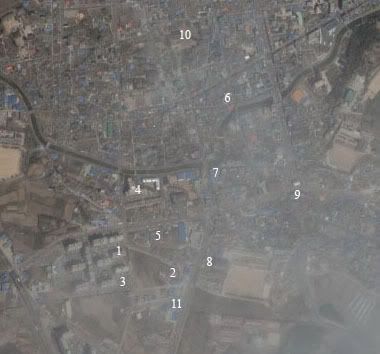the city where we live

It is effectively a suburb of Gwangju, but there are a number of things that make it very unlike suburbs proper. For one, it has its own unique history as a town. There are a dozen historical buildings and structures throughout the city that are maintained as heritage sites for tourist purposes. It is also very unlike a suburb in its density. The downtown is like any big city's downtown, only smaller. The streets are narrow and the buildings tall, with separate offices and stores on all floors. The people drive like lunatics and you take your mortality in your own hands when crossing any street. As far as I can tell, most of the population of Naju lives in the few large complexes of apartments like the one where I live. There are parts of town, though, where all the buildings are traditional Korean houses. Looking at those houses, though, it isn't obvious whether those with their own houses are richer or the ones who live in apartments are better off. As far as I can tell, all the homes here are traditional and have belonged to those families for generations. But what do I know?
Here's a map of a number of places that we go in the normal course of our lives. When you find something that actually works here, you stick with it, so I'm sure these place will remain fundamentals in our lives until we leave in eleven months.
(click image for larger version)
1) The building that we call home, distinguishable from the other buildings around it only by a thirty foot tall number on the side.
2) The academy where I go five days a week for almost every one of my waking hours.
3) The corner store that's open past midnight every night of the week and the stationary store where we can buy pens, stickers, binders and all that other crap that teachers need to replace on a weekly basis.
4) The apartment where the other english teachers live, who happen to also be the only people we know who speak our language.
5) Haneramart, the grocery store where it is surprisingly easy to shop and find what you're looking by the pictures on packages, even without understanding a single written or spoken word.
6) Lambada house, the first restaurant where we ate in Naju. It is easy to get food there and the food is predictably normal relative to other places that you can go.
7) "Mexican" chicken restaurant, the place that we ate a couple nights ago. There is nothing mexican about this place besides maybe the cream colored textured walls (and that takes imagination). It only serves fried chicken, but it's better fried chicken than you can get at KFC and so I'm sure we'll be going back to this place often. Only downside is that it takes about an hour to get served.
8) The bus stop where we catch our bus to Gwangju. Incidentally, it's right across the road from the school.
9) The "south gate" of the city, supposedly one of the historical sites of the city, is important in my life only because when I see it I know that I need to get off the bus at the next stop.
10) This is Naju's town square. It was at the heart of the festival that was going on the weekend we arrived; complete with a stage with live music, a laser light show and fireworks display.
11) This is the $5-all-you-can-cook restaurant where you can help yourself to as much beef as you want without even getting death stares from the proprietors.
This isn't an exciting map, but it gives you a sense of how contained the course of our lives are. Lambada House is probably less than a mile from our house. I hope to get to the point soon where I can get comfortable with exploring beyond my self-constrained mini-world, but at this point I can barely recognize the things I see around me when I'm on my beaten path. I guess it's because most buildings look similar and I ignore all the signs that I can't read anyway.



0 Comments:
Post a Comment
<< Home